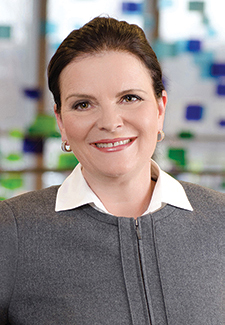In this month’s column, Teressa Szelest, the president of market and business development North America for BASF Corp., talks about innovation strategy and how BASF balances quarterly results with investments in long-term research and development.
How do you define innovation and what is your role in translating that into practice?
 Teressa Szelest: At the heart of our innovation strategy is our corporate purpose — we create chemistry for a sustainable future. BASF believes that being environmentally and socially responsible goes hand in hand with running a profitable business. Chemistry plays an essential role in addressing the future challenges of our world, including limited resources, climate protection, and feeding a growing population. Our customers are facing many of the same challenges, and they are looking to us to innovate the solutions that will meet these needs. Through our unique position as an integrated and global chemical company, we connect creative minds both within and outside the company to discover the best solutions for our customers.
Teressa Szelest: At the heart of our innovation strategy is our corporate purpose — we create chemistry for a sustainable future. BASF believes that being environmentally and socially responsible goes hand in hand with running a profitable business. Chemistry plays an essential role in addressing the future challenges of our world, including limited resources, climate protection, and feeding a growing population. Our customers are facing many of the same challenges, and they are looking to us to innovate the solutions that will meet these needs. Through our unique position as an integrated and global chemical company, we connect creative minds both within and outside the company to discover the best solutions for our customers.
How do you foster innovation at BASF — support and encourage employees to explore new ideas, engage in innovative problem-solving, and generate prototypes?
Szelest: BASF has the largest R&D spending in the global chemical industry and has approximately 10,000 employees dedicated to product and process innovation. Of these, approximately 2,000 scientists work at 27 BASF R&D sites in North America.
My role within BASF Corp. is to ensure that we continually incorporate the outside view and customers’ needs into our innovation processes, and that our organization takes appropriate action.
BASF collaborates with world-class universities, research institutes, companies, business professionals, and entrepreneurs around the world. We create a culture for innovation by balancing short- and long-term goals and by encouraging an exploratory mindset where “failure” is accepted and considered an important stepping stone to successful innovation.
How do you balance current performance — quarterly results, for example — with future concerns — i.e., innovation to meet future demand?
Szelest: We are very aware of the practical side of innovation, and work closely with our customers to ensure that we innovate to meet their specific needs as well as market demand. That means that for one type of business, focusing on new applications rather than a new product may be the appropriate solution. For example, we recently used a 50-year-old plastic polymer technology to meet a very specific customer need — lightweight materials for automobiles. Whereas in other areas, such as agricultural chemicals, a new molecule may be required.
That’s the advantage of being a company that has been innovating for more than 150 years. We rely on all aspects of innovation — from new applications for existing products to the development of new products, processes, and business models — to remain at the forefront of what we do.
How has your innovation strategy changed over time and what instigated those changes — for instance, changing markets, availability of new technologies, new competition?
Szelest: In September 2015, the United Nations (UN) Sustainability Development Goals (SDGs) were introduced. During the development of these goals, UN member states collaborated with various stakeholders, and BASF was among the corporate partners in this process. By combining the SDGs with our existing strategy to create chemistry for a sustainable future, we are providing ecologically balanced solutions that our customers, the market, and society expect.
For example, our new four-way conversion catalyst is helping automakers meet strict new emissions regulations. It removes particulate matter, in addition to carbon monoxide, hydrocarbons, and nitrogen oxides, from gasoline-engine exhaust. It also aligns with the SDG on climate protection.
This approach to innovation is increasingly required as our customers’ expectations evolve. They believe, as we do, that being environmentally and socially responsible goes hand in hand with running a profitable business.

Copyright Permissions
Would you like to reuse content from CEP Magazine? It’s easy to request permission to reuse content. Simply click here to connect instantly to licensing services, where you can choose from a list of options regarding how you would like to reuse the desired content and complete the transaction.
